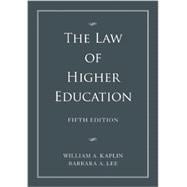Make sure you have a copy on your bookshelf.
The Law of Higher Education, Fifth Edition, is the most up-to-date and comprehensive reference, research source, and practical legal guide for college and university administrators, campus attorneys, legal counsel, and institutional researchers, addressing all the major legal issues and regulatory developments in higher education.
In the increasingly litigious environment of higher education, William A. Kaplin and Barbara A. Lee’s clear, cogent, and contextualized legal guide proves more and more indispensable every year.
Over 3,000 new cases related to higher education have been decided since the publication of the previous edition, and scores of changes to higher education law are made each year. Every section of the fifth edition contains new material, including those related to:
- Hate speech and free speech rights of faculty in public universities
- Sharing of research with international colleagues
- Intellectual property and peer-to-peer file sharing
- Student suicide
- Campus safety
- Police and administrators’ right to search students’ residence hall rooms
- Governmental support for religious institutions and religious autonomy rights of individual public institutions
- Collective bargaining and antidiscrimination laws
- Nondiscrimination and affirmative action in employment, admissions, and financial aid
- Family and Medical Leave Act and workers’ compensation
- FERPA (Family Educational Rights and Privacy Act)









